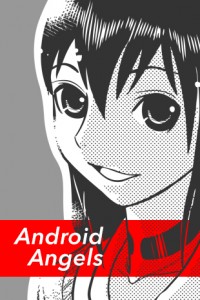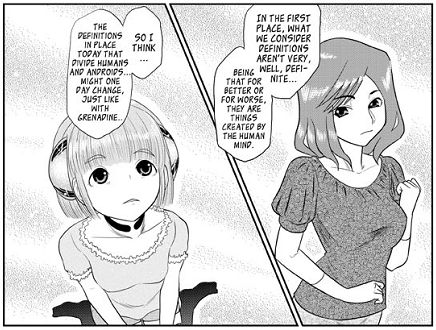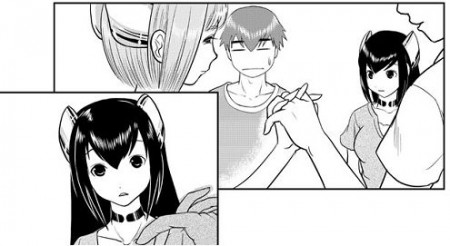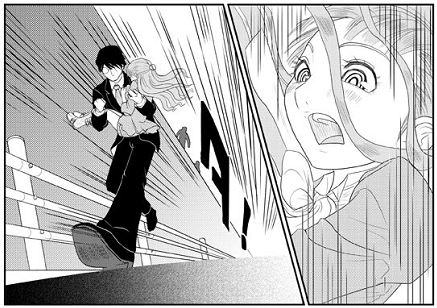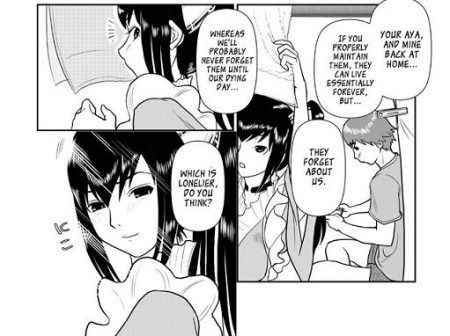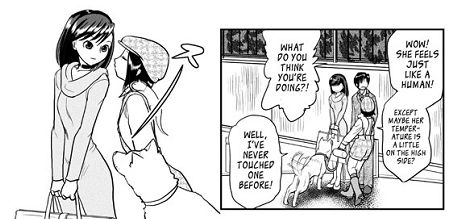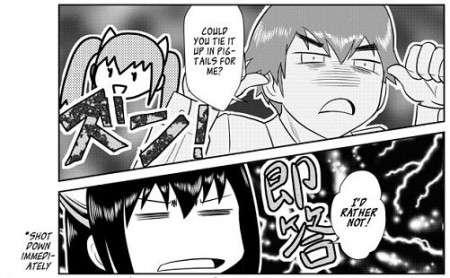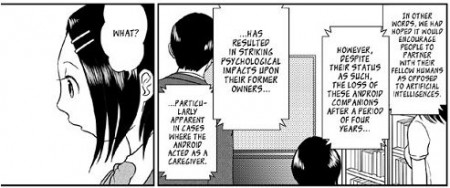Praise for Android Angels
Numerous well-known manga and anime have wrestled with the hypothetical circumstances of human relationships with androids or artificial people, such as Ghost in the Shell, Android Announcer Maico 2010, and Chobits. But it’s been largely left up to independent productions like The Time of Eve to penetrate beneath superficial comic relationships and stylized violence to examine the psychological effect that human and android relationships have on both parties. Amateur Japanese manga creator Kosuke Kabaya’s Android Angels manga follows in the footsteps of animator Yasuhiro Yoshiura’s Eve no Jikan to present its own thoughtful and affecting examination of human relationships in a world where not everyone that appears to be human actually is human.
The oversized 7×10 inch Android Angels graphic novel from GEN Manga compiles the complete story originally serialized from April to November 2012 in GEN Manga issues 11 to 16. The 158 page book contains three multi-chapter interconnected stories set in Metro City, a near-future metropolis in which consumers have the opportunity to rent companion androids for a span of four years. In order to discourage literally non-productive human/robot relationships and encourage human with human pairings that will bouy the declining birth rate, android memories are wiped clean every four years, a policy that introduces ethical questions about the rights of artificial humans and uncertainty about the jarring abrupt conclusion of intense, emotional relationships that humans establish with their artificial companions.
The first story, “Sakyu ni Houko,” introduces the setting of Android Angels and an initial, tentative tone. The two-chapter first story borrows a bit from the tone of “butler” manga series such as Hayate no Gotoku and Kuroshitsuji but adds a distinctive retro action feel, evoking the android battle action of Shotaro Ishinomori’s Cyborg 009. Kabaya’s art shows influence from anime and distinctly utilizes exaggerated perspective and cinematic panel layout reminiscent of classic anime.
The second single-chapter story, “Fruits Flavor,” turns to a more dramatic, subtle, introspective and mature tone to tell a story in the life of a professional woman that struggles to restrain her affection for her household android, knowing that the cute android girl will soon move on to a new owner and a new life. The bittersweet tale includes overt romantic sexual suggestion and takes deliberate care to present a balanced subjective and objective view on the rationality of humans developing romantic feelings for artificial beings, despite knowing that all relationships and connections that form will be arbitrarily severed in just four years.
The connected single chapter “Plastic Butterfly” and two-chapter “Metro City no Kaisen ni te” stories follow a single female android through multiple sets of owners, thereby subtly depicting the casual cruelty of giving androids free will so that they’re not helpless slaves, and making them indistinguishable from humans, yet robbing them of their identities and even their memories, all for the selfish sake of human convenience. Following a single android through multiple owners also allows the story to illustrate the devestating emotional toll that arbitrarily breaking up intimate relationships has on human beings that do remember their partners and the experiences they shared together.
As an amateur-produced manga, Android Angels isn’t without small flaws. While the art design is never bad, character designs and background art get tighter and more refined and detailed as the book and artist Kosuke Kabaya’s experience developed. Moreover, with only one volume, the manga only has opportunity to introduce its ethical and philosophical ideas. The stories are affecting and thought-provoking; readers can tell that Kabaya put considerable thought into the development of his ideas and stories. So it’s disappointing that there aren’t subsequent volumes of Android Angels to allow Kabaya to more opportunity to delve further into the philosophy, ethics, and humanity dynamic connections between humans and artificial humans.
The Android Angels graphic novel has been published from fresh master materials, resulting in the inclusion of three new chapter splash page introduction illustrations that were not included in the original GEN Manga serialization, and a small amount of incidental Japanese text that was translated in the original serialization slipping back into its original Japanese in the graphic novel – most noteably the title translation for the book’s final chapter. A single word typo from the original serialization, “grenadiine” spelled with an extra “i,” remains present in the graphic novel edition. A grammatical shift in verb agreement in the sentence, “They do not sell their products, rather leasing them out…” also remains uncorrected. Both are very minor and easily overlooked errors. The “Fruits Flavor” chapter has some slightly stilted dialogue translation, possibly due to the English translation adhering too closely to a literal translation, but many casual readers may not notice or mind the slightly clunky rhythm of the dialogue translation in one chapter.
Android Angels is one of the pleasant surprise gems that emerges periodically from the underground manga community. It’s a thoughtful and moving selection of inter-related speculative stories that remind readers that manga can be simultaneously cute, fun, intelligent, and just a little bit melancholy. Readers that have already acquired GEN Manga issues 11 to 16 may have little need of this collected edition, but readers that haven’t discovered Android Angels should find this a nuanced, touching, thought-provoking manga worth periodically re-reading.
